blog
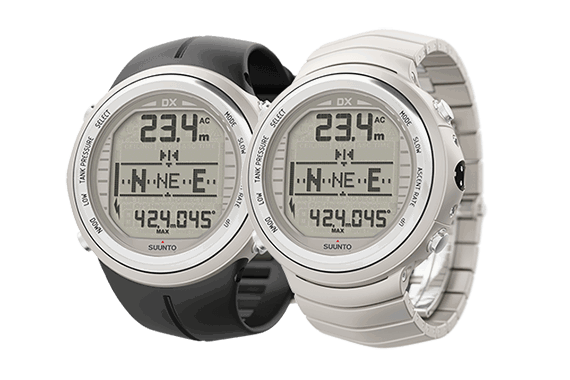
Suunto unveils the Suunto DX Silver watch-sized dive computers
The Suunto DX, introduced in January 2013 as the world’s first CCR-compatible wrist-sized dive computer is now available in silver too. Coming with a titanium or elastomer bracelet, the Suunto DX Silver is both a serious diving tool and a stunning piece of design. Check out the new variants online or at your local Suunto dealer where it will be available soon.
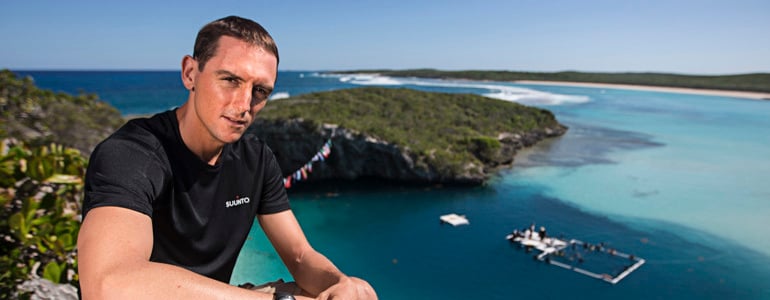
Will Trubridge: My new year goals
It's only a couple of months since Suunto Vertical Blue but Will Trubridge is already looking ahead to his next record attempt. Here's what else the year has in store for the freediver.
So what's up in 2015? 2015 is a busy year, with Suunto Vertical Blue happening at the end of April, then the Caribbean Cup in Honduras in May and the World Championships in Cyprus in September. I would like to perform well in all of these, but it's hard to maintain peak performance for long periods, so I will have to structure my training and rest carefully.Will you try again for another record?Yes, I hope so! Vertical Blue in April will have the best conditions for this, and with some solid training over the winter I would like to have another attempt at the 102 m [CNF – no fins, completely unassisted] and possibly try and push the Free Immersion record out some more as well.
Will in action during Suunto Vertical Blue. ©Daan Verhoeven
Looking back, what was the highlight of 2014? Winning Suunto Vertical Blue was definitely a great feeling, but I think the highlight would have to be seeing all the support for my world record attempt at 102 m, both before the attempt, when everyone was writing in with encouraging messages and leaving audio clips on the Steinlager site, and afterwards, when despite failing at my goal there was an even greater flow of support. Is it disappointing not to get the record?It can be a disappointment when you have trained hard for a long period, and there is a lot riding on your success. However you can learn as much from failure as you can from success, so I plan to use this disappointment as both motivation and a learning experience for the next occasion.
A freediver in action during Suunto Vertical Blue 2014. ©Logan Mock-BuntingWas there a single thing that sums up the event?After last year's incident this VB was characterised by a more careful approach from the athletes, and enhanced safety measures from the team. In a way it was inspiring to see the prudence displayed by an athlete voluntarily sitting out the entire competition because they had suffered a lung injury in training, when the previous year they might have tried to push through regardless. But rather than sulking at home, this person, and others who had similar conditions, showed up at the beach to coach their fellow athletes and support the event. I think this demonstrates the spirit of VB, where everyone is supportive of each other, and the unique environment at Dean's Blue Hole allows for a warm and intimate event.Anything else that stands in the memory from 2014? I heard whalesong underwater for the first time, which is a magical experience, and encountered my first tiger shark (a fleeting visit, as it was a little timid). My 97m no fins dive in the Caribbean Cup, which is the deepest dive in this discipline during a competition, was one of the competitive highlights for me.

From Roman ruins to tectonic plates: 2014 was quite a year for Jill Heinerth
Diver, cave explorer – someone who just loves to go diving at every opporutunity. 2014 has been memoroable for many reasons for Jill Heinerth. Here's why:
Any memorable dives of the year? Diving in the rift between the Eurasian and North America tectonic plates in Iceland was a real highlight. Slinking through towering icebergs in the misty ocean near Disko Bay Greenland was unforgettable and snorkeling with ten women across the Arctic Circle was a memory I will not soon forget.
Was there anything you feel gutted you didn't do? I traveled to Croatia for a diving event that was fabulous but I had hoped to do some significant cave diving as well. Europe was experiencing some epic flooding at the time and many of the regions for cave diving were inaccessible.
But you still went diving? I can’t really complain… I did get a couple of caves dives in any case and a terrific visit to a 1st Century Roman shipwreck. The archaeological work was being conducted by a large group of international students. I spoke to them about exploration, science and water conservation and they took me to their workplace – a Roman wreck of great significance.Looking ahead to 2015, what's number one on your tick list?I am heading out on for cave diving project in Cuba. If all the travel permits come in, I will be working with some scientists on documentation and exploration. I’ll also do some training for local scientists who have not had access to international expertise in cave diving.
What other projects are you working on? I am working with an artist on some potential exploration of spring caves in Turkey. Many of these locations are significant Roman archaeological sites. Margaret Tolbert, painter and conservationist, has been traveling to Turkey for almost 30 years, painting the stunning landscapes around the springs. She is rallying an inter-disciplinary team that includes artists, scientists and explorers and I look forward on developing that project with her in the coming year.Where will you spend the holiday period? My holidays will be spent primarily underwater. I am working on some camera testing with a colleague from National Geographic. We are going to be cave diving with some new cameras and brand new lighting technology developed by Light and Motion. We were shooting some test photos and video over Christmas. For me, that is the best present I could ask for – a chance to do more of what I love most!
All images ©Jill Heinerth

Under the Pole project on ice
Mid-winter is traditionally a time for hibernation and holing up before the better weather of spring arrives. And so it is for the Under the Pole expedition who are currently over-wintering in Greenland.
“All our suppliers are now installed in front of Ikerasak in our wintering place,” the team say in their latest dispatch. “The strong winds of these last weeks have not let the sea ice form. We hope to see the WHY [the team yacht] immobilized in the sea ice at the end of December.”
“We have still two hours of light despite the fact the sun doesn’t rise any more above the horizon. Navigation is still practicable and we’ve made some back and forth to Uummannaq to pick up crew members and to protect us from the violent storms.
At the beginning of December we registered winds of more than 65 knots! During 20 hours the crew did shifts to keep an eye on the hawsers and to protect the boat from the icebergs that came and hit the boat’s hull.”
Despite this, diving conditions have been exceptional. “Visibility is magnificent, worthy of the incredible environments that we found at the North Pole in 2010. This winter is going to be remarkable,” adds Ghislain Bardout, expedition leader.
Under The Pole is a series of submarine polar expeditions aiming to explore the hidden face of the Arctic and Antarctic polar regions in their diversities. The expedition, which is supported by Suunto, aims to further our scientific knowledge of the region and environment.
For more info: www.underthepole.com
All images © Lucas SANTUCCI / Under The Pole

#Paradise contest closed. Winners announced soon
The #Paradise contest is now closed and we will be announcing the lucky winners soon. Thank you to everyone for taking part. We have been overwhelmed by the number of images that you have sent in! Inspired.

3 days to enter #paradise contest
Crystal clear waters, incredible sealife, unspoilt beaches and untapped diving sites. And did we mention the pure luxury that only Ayada Maldives can offer? You could be enjoying all this and more next month but only if you send us your most memorable diving moment.
There are just three days left before the contest closes. Already we have been inundated with your submissions – over 1,000 received so far. But we want to see more. Check out the collage below for some inspiration and then click here for all the details on how to enter.
The contest closes at 9am CET, Monday 8th December. We look forward to seeing your entry!
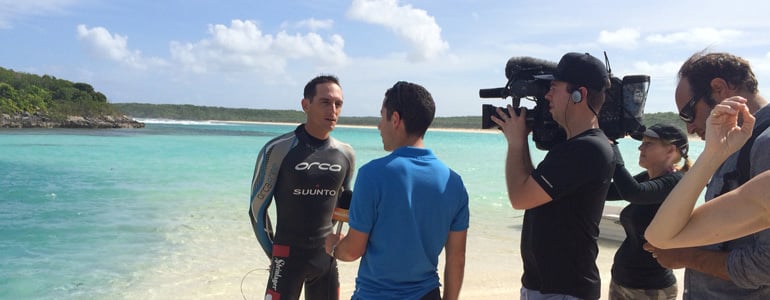
No new world record for Will Trubridge
The line between success and failure is a fine one – something the freediver Will Trubridge knows only too well. He has notched up 15 world records during his career. But yesterday, he did not manage to add another to his tally.
His attempt to reach 102 m in the completely unassisted discipline of CNF – where divers descend and ascend without fins or any other aids – was not successful. He reached his target depth but got into trouble near the surface and signalled for help to make the last few meters and was helped to the top by the safety divers.
Watch the epic video of his performance here:
Speaking afterwards Will said: “There's definitely disappointment about not reaching the goal I set myself. I prepared a lot for this dive and I feel like everything went well. In the freefall I was feeling good but just today, I just wasn't quite capable.
Though I'm disappointed not to achieve the goal, there is some content in the fact that I gave it my utmost best shot. And so much of my motivation to pull out all the stops in this attempt today came from the numerous messages of support that I have been receiving in the lead up.
I'm definitely going to attempt this again. This was just a plot twist. I will probably have another crack in the Spring.”
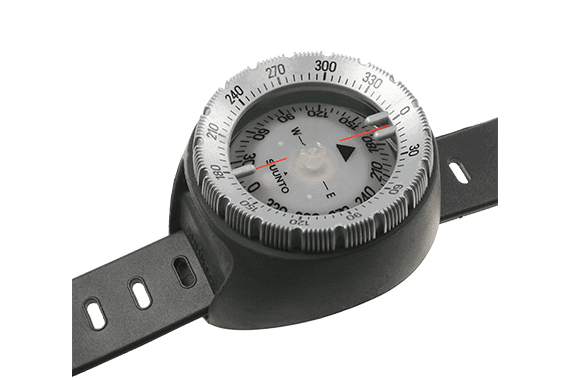
Suunto unveils a new dive compass
Suunto is releasing a new edition of the world's most popular dive compass, the Suunto SK-8.
SK-8, an update of Suunto’s leading dive compass, features new fonts for enhanced readability underwater and an improved construction for faster stabilization.
Both northern and southern hemisphere models can be used over a wider area of the globe thanks to an upgraded magnet – meaning you can have total confidence when following your dive plan.
The Suunto SK-8 is available from December 2014.
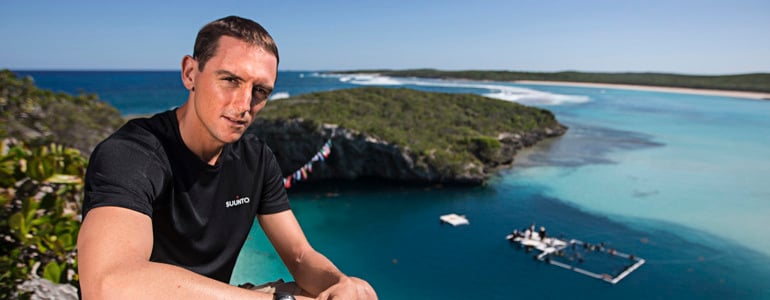
Trubridge attempts to break World Record
Today Suunto ambassador William Trubridge is going for the big record, the one he's been building up for – 102 m in Constant Weight No Fin (CNF), the purest freediving discipline. It's where divers descend and ascend without any artificial means. “Unassisted freediving is where you're freediving with no fins or any propulsive assistance of any kind and trying to go as deep as possible on that one lungful of air,” says Trubridge.If successful, it will break his own record of 101 m. The dive will last just over 4 minutes and will be split equally in time between descent and ascent. "I don't have a fear of being at depth or going to 100m, but I do have a fear of not making the dive perfect or being disqualified and essentially failing," adds Trubridge. This week he has made a couple of warm-up dives, one of which did not go to plan. Despite taking place in the Bahamas weather has been cool and Trubridge began his first big dive shivering from the cold which affected his performance. But before heading into the water today he was feeling confident. “I still feel that drive and thirst to go deeper. It hasn't been quenched yet,” he says. The dive will take place at 11 am EST. Stay tuned to Facebook to find out how it went.
Today was looking to be another action packed day at Suunto Vertical Blue with 11 other National Record announcements and an average depth of 79m!
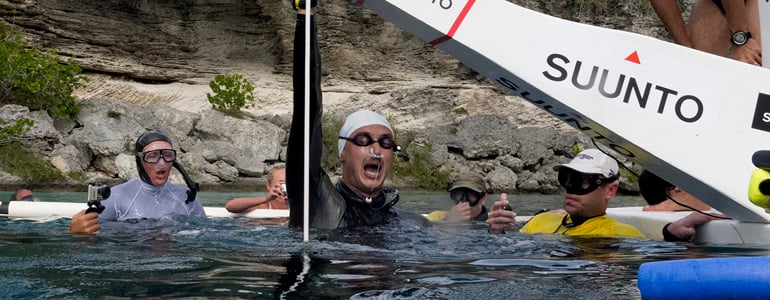
The deepest dive yet – and other Vertical Blue highlights from the weekend
Windy conditions at Deans Blue Hole didn’t prevent deep dives and exceptional performances during the weekend at Suunto Vertical Blue.
On Saturday the competitors broke three national records. Kate Middleton of New Zealand dove to 68 m (CWT), Alejandro Lemus of Mexico to 86 m (FIM) and Ryuzo Shinomiya of Japan to 60 m (CNF).
In this Day 3 highlights clip you can check out an interview with Mexico's Estrella Navarro Holm of Mexico and other highlights from the third day of competition including a new CNF record from Ryuzo Shinomiya of Japan.
Meanwhile in this clip you can watch highlights from day two of #VB2014, including interviews with Kate Middleton of New Zealand, Lena Jovanovic of Serbia and scenes from Deans Blue Hole.
Main image: ©Rebecca Woodmore
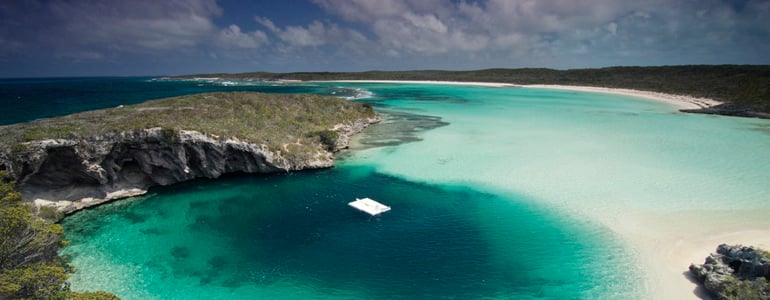
Record breaking first day at Suunto Vertical Blue
On just the first day of Suunto Vertical Blue seven freediving records were set!
Here is a peek at the South American record set by Carlos Coste of Venezuela (64m CNF), along with national records by Mateusz Malina of Poland (113m FIM), and Samo Jeranko of Slovenia (102m CWT). Enjoy!
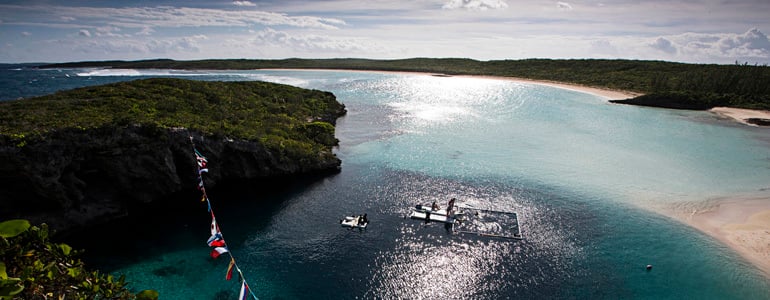
Top freedivers prepare for Suunto Vertical Blue 2014
Freediving is a sport that pushes the limits of human possibility. Divers descend to incredible depths of the ocean – all in a single breath. From November 27th to December 5th, the world’s top freedivers will gather in the Bahamas for one of the largest freediving competitions – the Suunto Vertical Blue. Founded and organized by record-breaking freediver William Trubridge, the invitational competition will see 35 divers from 19 countries compete at Dean’s Blue Hole in the Bahamas. Plunging to a depth of more than 200 meters, Dean’s Blue Hole has a reputation for being one of the greatest freediving locations on the planet. Its deep, warm and calm waters provide freedivers with the perfect environment to attempt to break national and world records, or exceed their own personal bests.
This year, Alexey Molchanov and William Trubridge will renew a rivalry that has intensified over the last couple of years. Between them they hold the current world records in the sport’s most popular depth disciplines. Trubridge is looking to improve on his world record 2010 CNF dive to 101 m. “It's the purest discipline,” he says.As for the ladies, the competition between Misuzu "Mimi" Okamoto and Tomoka Fukuda will be one to watch – they were both on the Japanese national team along with Hanako Rose – who took gold at this year's World Championships in Italy.
Says organizer William Trubridge: “This year's Suunto Vertical Blue promises to be another gripping event. The beauty of the event is that every athlete gets up to six attempts, so they can build up to huge performances and record attempts, or try to consolidate across all three disciplines for the overall prize. This is a recipe for nail-biting finishes and monster performances in the world's best freediving location.”Says Joan Sola, global sports and community marketing manager for Suunto: “We are pleased once again to be a partner of Suunto Vertical Blue, which brings together the world's top freedivers. Whether pushing the boundaries of human possibility or their own potential, it is an amazing festival of freediving. Suunto has worked with William for a number of years and we are proud to support him in his many record-breaking dives.”
We will be updating these pages regularly with the latest news from Dean's Blue Hole. You can also follow live on the official Vertical Blue Facebook page.

Infographic: What happens when you go deep?
What happens to the body when you go deep? This infographic explains some of the physiological changes that the body goes through on a dive. But one thing it can't explain – and that's the feeling.
Says Will Trubridge: “I love freediving because it's an opportunity to escape from gravity, sound, light (if you go deep) and even the sensation of time passing. A deep freedive can be like a dream, in that all the rules of reality seem changed.”
Dive in below to discover more about the sport, the physiology and the different disciplines...
infographic created by: zooom.at/Adi Sumic
The Dive Reflex
It is often said that humans are perfectly adapted for diving underwater thanks to the 'mammalian or dive reflex' – something we share with other aquatic mammals such as whales and dolphins. The main feature of this is the way the heart rate automatically slows once the face is submerged in water to reduce oxygen consumption. The dive reflex kicks in again after approximately 25 m: the heart rate slows by as much as 50% and vasoconstriction takes place. This is where warm blood retreats from the body's extremities to protect core organs.
At this depth most divers can stop swimming. “Here I have lost enough buoyancy from lung shrinkage under pressure that I can stop swimming and freefall for the rest of the descent,” says Will.
Freediving Disciplines:
There are three main depth disciplines in competition freediving: Constant Weight No Fins (CNF): The freediver descends and ascends without any assistance (only using arms and legs without fins).Constant Weight with Fins (CWT): The freediver descends and ascends using fins/monofin and the use of arms.Free Immersion (FIM): The freediver dives without the use of fins/monofin, but pulls a rope during descent and ascent.Says Trubridge: “CNF and CWT are the two most popular disciplines. CWT gives the deepest performances, while CNF is seen as the purest expression of human aquatic potential. FIM is more of a relaxed discipline, but there are definitely some very serious practitioners there as well!”

Suunto introduces new colors for D4i
The all-round dive computer comes out in two new editions
The Suunto D4i is now available in two new colors to guide divers on their underwater adventures.
With four dive modes – including freediving – Suunto RGBM algorithm, and the option of wireless integration, the Suunto D4i is the dive computer of choice for all divers looking for a lightweight, reliable and stylish dive computer.
With the pink edition, it gets a splash of color. It's the perfect fit, whether blending in with a coral reef or your style out of the water. The gray Suunto D4i makes for a modern and streetwise alternative to black.
The Suunto D4i is already available in black, white, blue and lime. It features a soft silicone strap, ensuring maximum comfort as well as a superb fit and is designed to suit the needs of all divers – for every diving occasion.
The Suunto D4i Novo Pink and Gray will become available in January.

Suunto releases the Suunto DM5 dive planner
Suunto is rolling out its latest dive planner, Suunto DM5. The Suunto DM5 (Windows/Mac compatible) allows you to download your dive logs for advanced analysis and create dive plans.
DM5 offers a quick and easy way to plan your profile and gases. You can also plan a series of dives. Transfer planned gases and settings to your compatible dive computer with a single click.
For the upcoming Suunto EON Steel, the fully customizable dive computer with a bright color screen, DM5 provides display customization and firmware updates.
DM5 supports the following Suunto dive computers: D4, D6, D9, D4i, D4i Novo, D6i, D9tx, DX, Zoop, Vyper, Vytec, Vytec DS, Cobra, Vyper2, Vyper Air, Cobra2, Cobra3, HelO2, EON Steel. Once installed, DM5 automatically recognizes your Suunto dive computer.
For further information about DM5, please click here.
Instructions for new users and current DM4 users:Download Suunto DM5 for free here:FOR WINDOWSFOR MAC
Current DM4 users will automatically receive a notification to update to DM5.
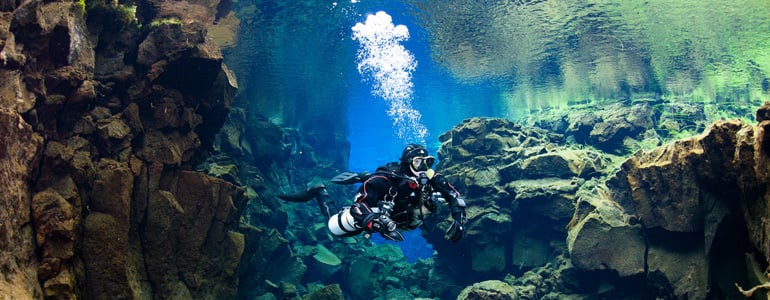
Suunto EON Steel: tested in the tropics to the Arctic
The Suunto EON Steel was created with the feedback of active divers from all over the world. Among them was our own ambassador Jill Heinerth. In case you don't know Jill, she's a renowned underwater explorer and 2013 recipient of the Sir Christopher Ondaatje Medal for exploration from the Royal Canadian Geographical Society. She's dived inside caves, underneath icebergs and in some deep waters all over the world – the ideal person to put the Suunto EON Steel through its paces. Here's what she had to say about Suunto's new launch: We're guessing you gave it a good testing! I first took the EON Steel to Christmas Island on a unique cave and deep ocean exploration project sponsored by National Geographic. The device was in its earliest form, but I could already understand the potential of the product. I wasn't really supposed to show it to anyone, so I had to quietly hide it in my pocket until we could snap a few photos! I finally had the chance to dive a fully functional device in France when other Suunto Global Distributors got to see it for the first time. The boat was buzzing with excitement form everyone that used it. And you also used in the Arctic right? Later, I took a unit to Newfoundland and on the Sedna Epic Expedition to the Arctic this summer. It was on these trips that I had the full opportunity to appreciate its full potential and functionality. I realize now that I have taken it from the warmest to the coldest conditions on the planet in the last year. I'm never very kind to my gear but it doesn't need to be handled with kid gloves. It is well built and simply works!
Jill Heinerth tested the Suunto EON Steel in both warm and cold climates. ©Jill Heinerth
What was the feedback you gave Suunto?What I saw in the Suunto EON was far beyond a typical diving computer. The EON is capable of taking a diver from their first dives, through technical and eventually CCR diving. The beauty is that the diver can customize their display and won't be mired in unnecessary features that they are not ready to use. As they progress, they can move to new modes of diving and use additional features. Furthermore, I envision the EON as more of a platform than a singular device that will need to be replaced. How do you like the product?I love the quality build and easy readability of the EON. I also love being able to plug it in for recharge or downloading.How is it different to previous dive computers you've used. The EON feels fully modern and fresh – more like my iPhone than a tired old diving computer display that looks like a relic of Windows 98. The EON interface is simple and intuitive and although it came with excellent instructions, there was no need to refer to them. The three button operation was obvious and features were easily found and activated. The audible alerts are also intuitive with unique, well designed sounds that make sense. The alarms alone can guide the diver to correct their behavior. Anything else? I was using the EON with a cave survey class recently and should add that the compass feature on the computer is extremely easy to access, very accurate and quick to respond. This feature can be used easily without losing other critical display information.
Jill Heinerth is a Suunto ambassador. Discover more about her exploits and photography here.
All images ©Jill Heinerth
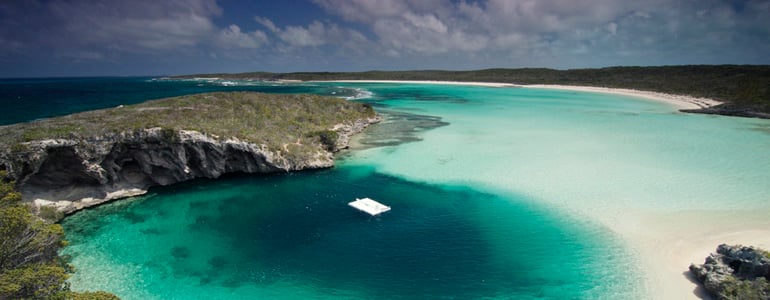
Suunto Vertical Blue: the venue that makes it so unique
The location for the Suunto Vertical Blue could not be more conducive to diving deep. Dean's Blue Hole is a natural wonder and is the deepest known blue hole in the world. Situated off Long Island in the Bahamas, it opens up approximately 10 m beneath the surface before plunging to 202 m. “It has a reputation for being the greatest freediving location on the planet,” says multiple record holder and Vertical Blue organiser Will Trubridge. “Its deep, warm and calm waters which are literally a step off the beach, provide the best environment for freedivers to attempt to break national or world records, or just to exceed their own personal bests.
Spectators on the beach. Photo ©zooom.at/Samo Vidic
“Spectators can watch the whole event from the warm Caribbean water, while feasting on local seafood salad that is prepared on the beach,” he adds. “It is an event like no other, not just in freediving, but in all sport.”One of the area's attractions is also its remoteness. Long Island, Bahamas is not as developed as many Caribbean destinations – just getting there is an adventure. Hotels and bars are laid back and you're unlikely to bump into lots of other tourists. In fact, during the nine days of Suunto Vertical Blue, probably every hotel guest will be a fellow freediver, which adds to the familiar atmosphere that makes the event so special. Dean's Blue Hole, the view from 15m. Photo: zooom.at/Agustin Munoz

The wait is over: Suunto launches the EON Steel
The next generation dive computer is here, offering full customization and amazing color screen.
What's next for dive computers? That question has come a little closer to being answered today as market leader Suunto unveils the Suunto EON Steel, the first fully customizable dive computer. It's so intuitive it takes ease of use to a new level.
Full customizationWith Suunto CustomDisplay™, you can tailor your EON Steel so that it shows exactly what you want. You can choose from a traditional text-based interface or a graphical view, and customize up to five different displays with Suunto DM5 software, the program that transfers your logbook data to your computer for detailed analysis.
Unrivalled clarityThe EON Steel also offers divers unrivalled clarity thanks to its new, innovative wide-angle BrightSee™ screen. The brightness, high color contrast and easy handling mean the display can be read in all conditions, whether you're diving in shallow and light waters, or deep and dark ones.
Comments Mika Holappa, Dive Business Unit Director at Suunto: “We are delighted to launch the Suunto EON Steel, which is the result of our desire to produce the best possible diving computer for active divers. Its customization possibilities and ease of use make it ideally suited to every diving occasion.”
Diving with you for years to comeThe Suunto EON Steel will grow with you as your diving and skills evolve, thanks to the way you can customize it to your needs. With user updatable software, including a free fixed point CCR upgrade in 2015, it will dive with you for many years to come, whatever diving you're into. It comes with the choice of a strap or bungee attachment so it can be physically customized as well.
The Suunto EON Steel uses the highly advanced Suunto Fused™ RGBM algorithm to maximize your dive time. When used together with the new Suunto Tank POD, you can get tank pressures from multiple PODs with just a glance at the wrist. The EON Steel is rated to 150 m and offers a dive time of 20-40 hours after one charge – meaning it's ideal for those week-long liveaboard trips.
Finland-based Suunto has developed many diving innovations in the last 50 years – including the first diving compass and early dive computers. Creating reliable products that are tested and designed for the harshest of elements has been a part of its heritage for almost 80 years.
The Suunto EON Steel builds on that tradition. The bezel is made from brushed stainless steel while the housing uses reinforced composite. The Xensation™ glass display is also built to withstand every diving situation. Inside and out the Suunto EON Steel is made with the most advanced components, making it extremely durable and accurate. It's another reason why the Suunto EON Steel makes the perfect partner for your diving adventures.
The Suunto EON Steel will be available in spring 2015, at the recommended price of €999. The Suunto Tank POD is available at €299.
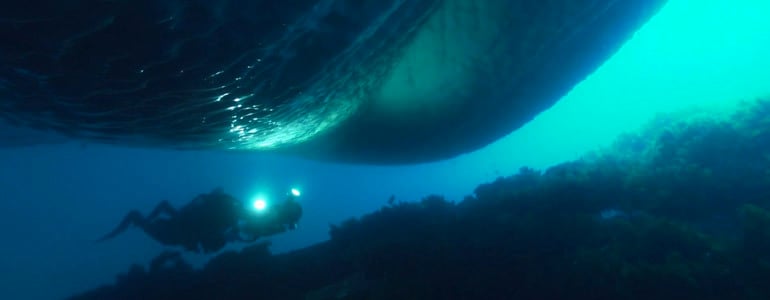
In the footsteps of the Fram
In their latest update, the Under the Pole team share their Arctic adventures, which included a visit to Canada's Ellesmere Island.
“Adventure is full of pleasant surprises and twists,” writes Ghislain Bardout in his latest newsletter. “We stopped in one of the wintering grounds of the Fram, the iconic polar exploration ship [of explorers Nansen and Amundsen]. It was here, alongside a glacier, where an idea emerged: what if we went exploring its underside?”
© Lucas Santucci / Under The Pole. “Ghislain and Martin spend several hours every day to prepare their recyclers and make their gas mixtures. Before getting on the water, the concentration is maximum, misinterpretation or an error can be fatal at these depths.”
“We experienced magical and rare moments,” adds Ghislain. “In the Arctic, a cairn is a hollow that allows leaving messages for future travelers. In an Ellesmere cairn we found a previously undiscovered box containing a message recounting a 1925 expedition.”
The team, who are exploring Greenland's coastline, sailed as far north as they could get before ice blocked their path at 80°23N. “We docked to an ice floe in order to achieve the northernmost scuba dive of the expedition,” continues Ghislain.
© Martin Martin - Lucas Santucci / Under The Pole. Life and light returns after a 100 m dive.
“The second half of August was devoted to finding a wintering place in the Bay of Qaanaaq. After speaking to locals and exploring various sites, the team settled on Uummannaq Bay further south. “Wintering in Uummannaq Bay is also a great happiness for us, since we loved the dives and made good friends there,” adds Ghislain.
www.underthepole.com
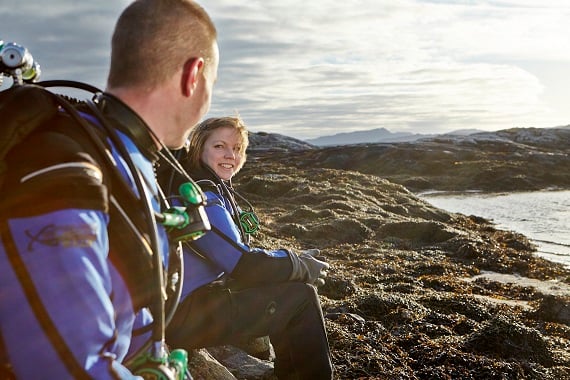
Suunto's next generation dive computer
What’s next for Suunto dive computers? That question will be answered this fall when we unveil our latest creation for divers seeking the best. This advanced, large display dive computer with a bright color screen grows with you.
Suunto has developed many diving innovations in the last 50 years together with divers - including the first dive compasses and early dive computers. Our next dive computer continues this tradition of co-creation with you - our diving family - and we thank you all for your valuable feedback.Creating reliable products designed for the harshest of elements is a part our near 80-year heritage. The next great Suunto dive computer adds another chapter to the extraordinary Suunto story.
Want to know more? Sign up here and you'll be the first to receive additional details about this exciting new product.
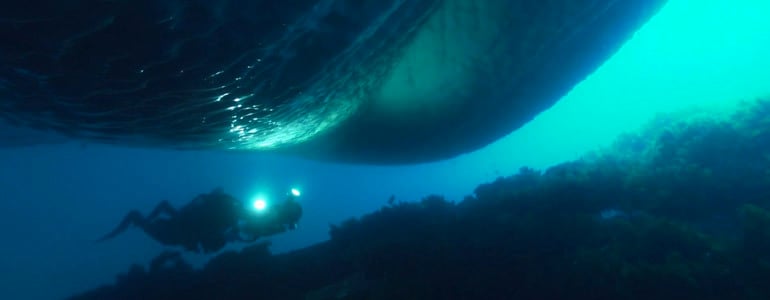
Video: Diving under the ice
For the Under the Pole team journeying up Greenland's west coast, the last few weeks have offered spectacular diving – and some interesting culinary discoveries. Click on the video below to see for yourself.
The French team of explorers and scientists made their way from Uummannaq to Qaanaaq, one of the most northerly villages on earth. Along the way they sampled some local cuisine – guts rolled around skin and fat – and have encountered much wildlife, including various seals and whales. A highlight was a scooter assisted dive under an iceberg.“Navigating the wild coasts is wonderful,” says Ghislain Bardout, expedition chief. “Last month we sailed throughout Melville’s Bay, the least habited and wildest region of Greenland’s West Coast. We would have loved to stay a couple of weeks more in this magic place.” The team are now at Qaanaaq's Bay where they will prepare to hibernate on board their ship, the WHY and spend the winter.
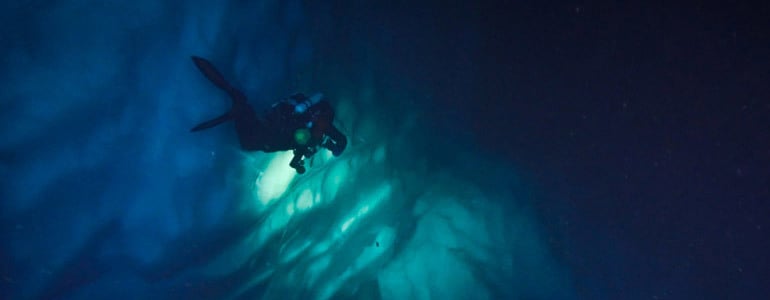
Summer arrives for the Under the Pole team
“Summer arrives, icebergs melt, mosquitoes are everywhere!” So begins the latest newsletter from the Under the Pole team. The expedition, which consists of explorers, scientists and divers, is journeying up the coast of Greenland in a bid to chart the west coast, both from above and below the waterline.
The team set off from France at the beginning of January on the 18m schooner WHY and spent the month of June moored in Ummannaq, which means 'heart shape' in Greenlandic.
All the team on (and in) the ice pack - © Lucas Santucci / Under The PoleThere the team carried out some decompression research. Says Ghislain Bardout: “We performed nine dives with similar profiles (80 m 1hr 30 immersion) which were 'listened' to afterwards via a Doppler device by Julien Hugo, scientist at BF Systèmes and specialist in measuring circulating bubbles concerning diving decompression. “The study is part of a scientific collaboration that aims to create a better understanding of decompression physiology in the arctic environment.”
Suunto dive computers take a rest in between research dives. © Lucas Santucci / Under The PoleAt the time of writing, the team were out of communication, en route to Upernavik and across the famous Melville Bay where they hoped to wait for the arrival of narwhals – tusked whales. The plan is then to head to Qaanaaq where they will over-winter. Main underwater photo: © Ghislain Bardout / Under The Pole
Check out the team's latest webclip here.

Dive into the world of a freediver
Will Trubridge has broken numerous freediving records but below, he reveals why he dives for the sense of exploration. Are you training for anything special? The fall is always the period of the year when I try and peak my training, so if everything has been going well over the summer then I will try to focus my efforts on one of the disciplines and see where I can get to. Is Molchanov's CWT record breakable? Every record is breakable! I worked hard on my CWT technique between 2012-2013, and I had an attempt in 2012 at the world record which failed by a whisker –forgetting to remove my nose clip on the surface. That dive was 125 m, and the record is now 128 m, so it is now an even bigger challenge, but not out of reach. My speciality has always been the no-fins discipline though, and it is also the one I enjoy the most. This year I'm concentrating more of my energy there.
Remind us why you freedive and what the sport means to you.I do it mostly for the sense of exploration and the challenge. By diving deeper than the human body has ever been we are redefining our limits as a species, and it is exciting to be on this frontier. I'm also the kind of person who needs to be challenged, mentally and physically, and freediving is a sport that supplies both.
Beyond both these answers, the sensation of merging with the water, and sinking deeper into a place where sounds, light, and all other stimuli are muted is an other-world experience that I am blessed to be able to enjoy.It must be tough having to train in all these locations like the Caribbean, Honduras...Tell me about it. I often long for a cold drizzle or snowfall... not! In fact I try not to forget that being able to combine a passion with a career and to be able to travel to all these magnificent places and dive in them is a dream. I'm grateful for every day and every second underwater.
It seems freedivers must lead very pure lives. Do you have any vices? I get so much fulfillment and nourishment from what I do that I really don't feel the need for anything more, especially something that comes at a price, like a vice does! However, could you call drinking hot sauce from the bottle a vice?Looking ahead, where do you think the sport is headed? Is it going to get more popular?Yes, I think it is. Some say our generation is living in an environmental and spiritual revolution, and freediving is a sport that ties in well with both those ideas. It simultaneously brings you back into touch with yourself and the environment in a way few other performance sports do. It is also the only truly aquatic (immersed) sport, so it offers an experience that is unparalleled in any other activity. A lot of people are discovering this, and finding a rewarding sport that leaves a light impression on our planet while drawing us closer to it and ourselves.Main image and portrait ©Samo Vidic. Underwater image ©Agustin Munoz

Why take a dive computer?
It's one of the most important bits of diving gear you can take underwater. The Scuba Diver Girls explain why.
A dive computer is one of your most essential bits of gear and can keep you safe when your dive plan changes, says Margo Sanchez, president of Scuba Diver Girls.“I saw a hammerhead shark,” says Margo. She and her buddy Stephanie had been diving a wall in Papua New Guinea with Tufi Resort. Their plan had been to stay at around 25m (80 ft) – but then they spotted this beautiful hammerhead, which typically patrols deeper depths. “It is better to have a computer that will help you adjust on the fly.”Sanchez did not want to pass up this amazing opportunity to get closer to this majestic animal and swam deeper. Her Suunto D6i alerted her of the depth. She kept her eye on her wrist so she could monitor how long she could stay at her new deeper depth while she filmed the great hammerhead. “Even though I wanted to continue to follow that beautiful shark, I used my Suunto to gauge when it was time to begin my ascent to shallower waters.”“Manual gauges won’t be there to assist you with your dive profile when your dive strays from your plan, and you can really get yourself into trouble.”
Margo notes that many things can change your plan while diving, and it is better to have a computer that will help you adjust on the fly. “Three minutes can seem really long when you are just hanging out in the big blue.”Sanchez finds that the upgrade to a computer from manual gauges has further benefits. “It’s also a timer – it counts your safety stop down for you,” she says. “Three minutes can seem really long when you are just hanging out in the big blue with not much to do. The computer tells you when it is safe to make your ascent to the surface.” Dive computers also track your time out of the water, so you know the second that the pool is open again for a second dive. Says Sanchez: “You can figure your surface interval with dive tables, but it is much easier to push a button on your computer and see exactly when it’s time to dive again.”She also likes her dive computer for its accuracy. “Gauges often aren’t accurate – on a number of occasions my air pressure gauge has been off by as much as 300 psi.” She likes the air integration with the computer where she can see very accurately what her psi is during a dive. Finally, Margo notes that there are other features of her Suunto that she loves. “The ability to check the temperature when I am diving in Southern California is great. The water can get pretty cold and it is fun to see real time what the temperature is.”
Also she likes to be able to scroll through her dive profile after the dive and see air consumption throughout the profile. “It is fun to keep track of all the amazing places we have been, where we dove, and what we saw there. You don’t get that with manual gauges!”
Image: ©Larisa Steele




























































